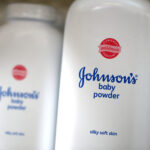Peter Earle has been representing child victims of lead paint poisoning for more than 20 years and he and his fellow lawyers for the cause are not about to let another legal setback affecting three cases bring an end to the fight.
They have more than 160 Wisconsin plaintiffs they are representing against paint manufacturers over lead poisoning and many more court dates to come.
“The defendants are pursuing a bet, the company litigation strategy, and we’re pursuing a fight-to-the-death strategy. We will not give up,” Earle said. “This in my view, and the view of the other lawyers, is one of the most catastrophic environmental injustices against mostly minority children this country’s ever seen. There are literally millions of children throughout the United States and hundreds of thousands in Wisconsin who are living in lead traps.”
Last week, a federal appeals court cleared one paint manufacturer and ordered retrials for two others, upending a 2019 case in which a jury had awarded $2 million each to three men who blamed their brain damage on their years of exposure to lead in paint.
The U.S. 7th Circuit Court of Appeals in a 62-page opinion (Burton v. DuPont) said the lower district erred in expanding the state’s shared liability theory.
When a Wisconsin Supreme Court decision in 2005 (Thomas ex rel. Gramling v. Mallett) adopted a “risk-contribution” theory of liability for plaintiffs suing manufacturers, it applied the risk contribution theory only to makers of a paint ingredient known as white lead carbonate. However, the 7th circuit court stressed, that high court opinion did not extend the theory to paint makers that did not themselves manufacture that ingredient but used lead carbonate manufactured by another company in their products.
In the opinion written by Judge Amy J. St. Eve, the 7th Circuit Court concluded that applying the risk contribution theory to paint manufacturers or finished paint products would extend Thomas beyond its bounds. It sent the $6 million verdict back to the lower court for a new trial.
The plaintiffs in the Burton consolidated cases are three young men who grew up in Milwaukee homes that had lead-based paint on the walls. They were diagnosed with lead poisoning as young children in the 1990s or early 2000s. Years later, they sued several manufacturers of white lead carbonate, seeking compensation for brain damage and other injuries resulting from their ingestion of lead paint particles.
After years of pretrial litigation, the plaintiffs went to trial against five manufacturers on claims of ordinary negligence and strict liability failure-to-warn. The jury found three of the manufacturers liable and awarded the plaintiffs $2 million each. The three defendants found liable were E.I. du Pont de Nemours, Sherwin-Williams and Armstrong Containers. The three companies appealed, challenging a long list of the district court’s rulings.
Now the federal appeals has ruled that paint maker Sherwin-Williams is entitled to judgment as a matter of law, Armstrong is entitled to judgment as a matter of law on the strict liability claims and a new trial on the negligence claims, and DuPont is entitled to a new trial on both claims.
“The court’s error requires a new trial because it significantly expanded the scope of the defendants’ potential liability and the evidence at trial. It also deprived the defendants of the opportunity to build an appropriate defense,” the opinion states.
The judge noted that for years, the defendants had litigated under the assumption that they were liable only in their capacity as pigment manufacturers. Less than six weeks before trial, however, the defendants learned for the first time that they were also subject to liability as manufacturers of paint products containing white lead carbonate.
“The court’s last-minute, legally incorrect ruling left them scrambling to adapt their defenses to the plaintiffs’ newly enlarged theory of liability,” St. Eve wrote.
Under the risk contribution theory endorsed by the state’s high court in 2005, a plaintiff does not have to prove that a specific defendant’s conduct caused his or her injury. It instead seeks to apportion liability among the “pool of defendants” who could have caused the injury.
Each of the defendants argued that the risk-contribution theory applies to them only if they manufactured white lead carbonate. The 7th Circuit Court agreed:
“[T]he Wisconsin Supreme Court has made clear that such companies are liable under the risk-contribution theory only in their capacity as manufacturers of white lead carbonate pigment. As a practical matter, this means that a paint manufacturer cannot be liable under the risk-contribution theory for selling a finished product that contains another company’s white lead carbonate. Only the manufacturer of the white lead carbonate can be liable.”
The district court and plaintiffs had based their more expansive reading of Thomas on the Wisconsin Supreme Court’s use of the word “marketed.” As the district court saw it, a company that sells lead-based paint is “marketing” lead pigment, even if it is not “producing” it. Thus, the court reasoned, a paint manufacturer could be liable for selling paint containing another company’s white lead carbonate. The federal court disagreed with this approach, calling it a “strained interpretation of marketing.”
The appeals court also found that the lower court erred in allowing testimony on lead paint’s effect on IQ from a witness without questioning the reliability of the methodology set forth by the witness.
Earle said he was surprised by the ruling but is confident about winning in the end.
“We see a very clear path to the retrial and the trial of all the other cases. And we’re confident we can win,” he said.
Earle noted that the cases are complicated because at some point in their history most paint manufacturers made their own carbonate but then stopped and incorporated others’ carbonate into what was essentially the same paint they sold.
“They didn’t change it. They just simply bought the white lead carbonate. The exact same product essentially generic. And so we felt they should be liable for that entire period of time. They said, no, the liability is only for pigment manufacturers,” Earle commented.
While he and his plaintiffs lost that part of the argument, Earle is actually encouraged by other parts of the 7th circuit opinion, including its support for the plaintiffs’ position on bifurcating the trial between the liability phase and the apportionment phase.
“The court said that while there is no ordinary negligence claim detached from a product defect, that there are other negligent claims based on product defect, other than an inadequate warning,” he explained.
He maintains there are post-sale instructions, warnings and mitigation efforts that the lead paint companies could and probably should have undertaken.
On retrial, he expects to pursue claims of product defect along with negligence and duty to warn. “It’s really easy to do because there is no dispute that the white lead carbonate constituted a hidden danger which foreseeably put children at risk,” he said.
He said his side has a “massive record of evidence” about what the companies knew, when they knew it, what was known in medical literature and among public health experts and consumer advocates at the time.
The remaining 160 or so cases in Wisconsin have been divided into three groups. The recent ruling involved the first of the three. But it’s unlikely there will be any more in Wisconsin as the legislature has ended the contributed risk theory for paint cases.
The federal government banned lead-based paint for residential use in 1978 and Wisconsin followed suit in 1980. Even after these bans, however, lead-based paint remains on the walls of many homes throughout the United States.
Wisconsin is not the only state that has been dealing with lead paint liability cases over the years. Other cases have been heard in California, Maryland, Mississippi, New York, New Jersey and Rhode Island.
Was this article valuable?
Here are more articles you may enjoy.


 Gallagher: Global Insured Natural Disaster Claims Again Dominated by Severe U.S. Storms
Gallagher: Global Insured Natural Disaster Claims Again Dominated by Severe U.S. Storms  California Sees Two More Property Insurers Withdraw From Market
California Sees Two More Property Insurers Withdraw From Market  Beyond the Claim: How Social Canvassing is Transforming Insurance Fraud Detection
Beyond the Claim: How Social Canvassing is Transforming Insurance Fraud Detection  J&J, Kenvue Told to Pay $45 Million to Baby Powder User’s Family
J&J, Kenvue Told to Pay $45 Million to Baby Powder User’s Family 